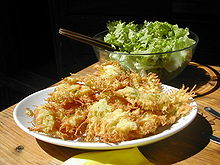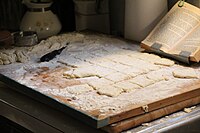Beignet
 Potato beignets from Haute-Savoie | |
| Type | Pastry |
|---|---|
| Place of origin | Ancient Rome |
| Main ingredients | Dough, powdered sugar |
| Variations | Sourdough |
Beignet (/ˈbɛnjeɪ/ BEN-yay, also US: /beɪnˈjeɪ, bɛnˈjeɪ/ bayn-YAY, ben-YAY,[1][2][3][4] French: [bɛɲɛ]; lit. 'bump') is a type of fritter, or deep-fried pastry, typically made from pâte à choux, but may also be made from other types of dough, including yeast dough.[5]
Types[]
This section needs additional citations for verification. (June 2021) |
The term beignet can be applied to two varieties, depending on the type of pastry. The French-style beignet in the United States has the specific meaning of deep-fried choux pastry.[5]
Beignets can also be made with yeast pastry,[6] which might be called boules de Berlin in French, referring to Berliner doughnuts, which lack the typical doughnut hole, filled with fruit or jam.
In Corsica, beignets made with chestnut flour (beignets de farine de châtaigne) are known as fritelli.
In Canadian French, doughnuts are referred to alternately as beigne or beignet.
New Orleans[]

Beignets are commonly known in New Orleans as a breakfast served with powdered sugar on top.[5] They are traditionally prepared right before consumption to be eaten fresh and hot. Variations of fried dough can be found across cuisines internationally; however, the origin of the term beignet is specifically French. In the United States, beignets have been popular within New Orleans Creole cuisine and may also be served as a dessert. They were brought to New Orleans in the 18th century by French colonists,[6] from "the old mother country",[7] also brought by Acadians,[8] and became a large part of home-style Creole cooking. Variations often including banana or plantain – popular fruits in the port city – or berries.[9][10]
Preparation[]
Ingredients used to prepare beignets traditionally include:
- lukewarm water
- granulated sugar
- evaporated milk
- bread flour
- shortening
- oil or lard, for deep-frying
- confectioners' sugar

Beignets before frying
Piping choux pastry dough for beignets
See also[]
- List of choux pastry dishes
- List of doughnut varieties
- Churro – Fried-dough pastry
- Cuisine of New Orleans – Culinary traditions of New Orleans, Louisiana, US
- Lokma – Deep fried dough pastries
- Mekitsa – Dish made of kneaded deep fried dough made with yogurt
- Puff-puff – African fried dough snack
- Sufganiyah – Round jelly-filled doughnut served at Hanukkah
- Zeppole – Italian pastry
References[]
- ^ "beignet". The American Heritage Dictionary of the English Language (5th ed.). Boston: Houghton Mifflin Harcourt. Retrieved 18 May 2019.
- ^ "Beignet". Collins English Dictionary. HarperCollins. Retrieved 18 May 2019.
- ^ "beignet" (US) and "beignet". Oxford Dictionaries UK English Dictionary. Oxford University Press. n.d. Retrieved 18 May 2019.
- ^ "beignet". Merriam-Webster Dictionary. Retrieved 18 May 2019.
- ^ a b c Davidson, Alan (1999). Oxford Companion to Food. Oxford University Press. p. 70. ISBN 9780192115799.
- ^ a b "Beignet History and Recipe". WhatsCookingAmerica.net. Archived from the original on November 9, 2016. Retrieved February 13, 2017.
- ^ Schneider, Wendi (1989). The Picayune's Creole Cook Book. New York: Random House. p. 385.
- ^ "Beignets". cafedumonde.com. Café du Monde. Archived from the original on August 24, 2018.
- ^ McKnight, Laura (November 16, 2007). "Beignets: More than Just a Doughnut". houmatoday.com.
- ^ "Of Interest to Women: Banana Served In Appetizing Forms". The Philadelphia Inquirer. January 1, 1907.
Further reading[]
- Yves Thuriès, French Pastry, ISBN 0-471-28598-6
- Rosana G. Moreira et al., Deep Fat Frying: Fundamentals and Applications, ISBN 0-8342-1321-4
External links[]
 Media related to Beignets at Wikimedia Commons
Media related to Beignets at Wikimedia Commons
- American doughnuts
- Choux pastry
- Cuisine of New Orleans
- French-American cuisine
- French pastries
- Louisiana Creole cuisine
- American breakfast foods


